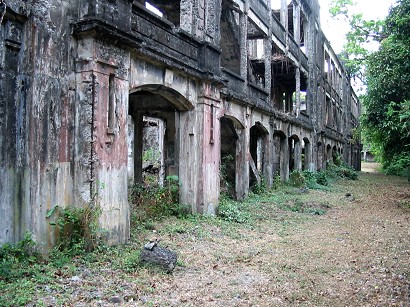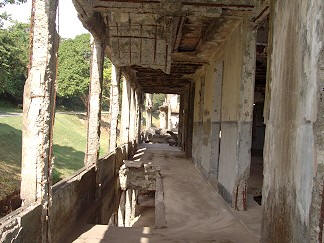The Filipino
nation has a
stake in
Corregidor and
all its
structures. I
think the public
has a right to
be informed
BEFORE a project
like this is
implemented.

A bed of
grass,
fallen
leaves
and
vines
creeping
up the
ruins
used to
make
walks
through
this
area
exciting
and
refreshing.
Somehow,
I can't
see how
paved
walkways
and
elevated
catwalks
could
even
begin to
approach
the
feeling
of
adventure
one used
to get
here.
(2004
photo)
3. Why are the
trees around the
building being
cut? I heard
that these trees
were eliminated
because they
posed a threat
to the building
during storms.
This reason is
not valid,
because many of
the trees are
several meters
away, and have
no way of
falling on (and
therefore
damaging)
Middleside
Barracks.
Behind this same
building, the
small trees and
saplings that
used to stand
somewhat closer
to the building
have also been
cut. Today, only
a long row of
small tree
stumps remain.
Surely, trees of
this size did
not pose a
threat to the
building. If
there were any
larger ones, the
they could have
have been balled
up and
transferred
elsewhere.
My photographs
show that they
are making
construction
materials out of
these trees. One
picture shows
sawdust on the
grass, along
several pieces
of lumber that
had just been
hewn out of
logs. Why are
they cutting
these scenic
trees?
|
|
|
Can't
they
get
their
lumber
from
somewhere
else?
|
For them to be
doing that in a
PROTECTED AREA
like Corregidor
Island is really
the height of
irresponsibility.
Let them not say
that Typhoon
Millenio felled
these trees,
because my
photos of tree
stumps show root
systems that are
still firmly
embedded in the
soil.
Furthermore,
Middleside is a
semi-sunken spot
in Corregidor's
terrain. With
Middleside
Barracks
shielding the
trees from
strong winds on
one side, and a
small hill
protecting them
on the other, I
could safely say
that these trees
were in no
danger of being
blown down.
|
|
|
Tree
trunk
and
root
show
cuts made
by a
chainsaw.
Tsk-tsk!
|
WHAT IS
THE SOLUTION
THEN?
1. Stop
this project
immediately
before more
damage is done.
2.
Examine and
reassess
Corregidor
Island's
original
development
plan.
This plan was
formulated
almost TWENTY
years ago, and
has been
overtaken by
newer trends and
concepts in
environmental
preservation and
protection.
Preferences in
the world
tourist market
have also
evolved. This is
particularly
important today,
vis-à-vis the
competition we
face from our
ASEAN neighbors,
as we vie for
much
sought-after
tourist dollars.
Corregidor is
our cutting
edge. Let's not
ruin it!
3.
Consult with
different
experts in
structural
restoration
and/or
preservation.
Get their
opinions and
recommendations
as to what
should be done,
the best way to
do this.
4.
Consult with
Veteran's groups
/ associations.
Consultation
should not be
restricted to
local groups.
Let us not
forget that not
only Filipino
troops fought
and/or died
here.
5.
Consult with
tour operators,
travel agencies,
and similar
organizations.
These entities
will be directly
affected by
radical changes
such as this.
They, too, have
a right to know.
6. Take
immediate action
to stop the
continuous
deterioration of
Corregidor's
structures.
Since I
"rediscovered"
Corregidor in
1995, I've
noticed the
continuous
deterioration of
Middleside
Barracks (and
other ruins as
well). When I
say
"deterioration",
I don't mean the
wear and tear
caused by the
forces of
nature, or the
damage the
building
sustained during
World War II,
but rather, the
seemingly
unfettered
chipping away of
these
concrete-based
structures.
|
|
|
Here
at
Middleside
Barracks,
the
disappearance
of
large
chunks
of
FLOORS
are
a
common
occurrence.
This
shot
was
taken
on
the
second
floor
of
Middleside
Barracks
This
is
definitely
not
bomb
damage!
(December
2006)
|
Close inspection
of floors,
walls, ceilings,
pillars and
other parts of
buildings will
show that more
and more of the
concrete is
disappearing.
Each time I
visit the
island, pillars
lose their mass,
walls become
thinner, and
more iron bars
become exposed.
One does not
need to be an
engineer to
surmise that
building's
structure isn't
as solid as it
was a few years
ago. Before you
know it, many of
these structures
will no longer
be standing.
|
|
|
This
excavation
has
grown
over
the
years.
Take
note
of
the
the
tree
branch
sticking
out
of
the
hole.
|
Inside the
Middleside
Barracks, holes
dug by unknown
persons is proof
that not enough
is being done to
protect these
historic
buildings. The
holes are about
two square feet
in size, and the
kind of cutting
jobs done on the
floor shows that
the people who
did this
certainly took
their time. One
hole has grown
in size over the
years. .
In the
mid-nineties, it
started as a
simple square
hole in the
conrete
flooring. Later
on, a small hole
appeared in the
soft soil
directly
underneath the
original hole.
After more time
passed, a small
crawspace
appeared, thus
making it a sort
of mini-tunnel..
|
|
|
Lo
and
behold!
The
little
tunnel
has
sprouted
its
own
laterals.
Surely,
this
kind
of
excavation
is
slowly
undermining
the
foundation
of
Middleside
Barracks.
|
Then, the
crawlspace
deepened, and
became large
enough for
people to to
squat in. A few
years ago, two
laterals started
branching out
from this the
mini-tunnel. The
depth and
breadth of the
excavation has
increased over
the years. Last
Wednesday, I
noticed a hole
that hadn't been
there two years
ago.
Not far from
Middleside
Barracks, the
old Army
Hospital
(incidentally,
one of the
least-damaged
and
best-preserved
buildings), also
shows signs of
manual
tampering. I
guess it won't
be long before
it starts
looking like
Middleside
Barracks .
|
|
|
Here's
another
photo
taken
on
the
second
level
of
Middleside
Barracks.
Notice
the
condition
of
the
pillar
in
the
extreme
right.
With
supports
like
these,
is
it
any
surprise
why
this
building
is
deteriorating
at
an
alarming
rate?
Falling
trees
blown
down
by
typhoons
or
moisture
caused
by
Banyan
trees
are
not
the
the
root
cause
of
the
problem
(pun
intended).
What
we
have
to
watch
out
for
are
"Cement
hunters"
in
search
of
filling
materials
and
"Iron
hunters"
in
search
of
scrap
iron.
Although
I
can't
understand
what
they
get
out
of
badly
corroded
bars
like
these.
Isn't
it
amazing
how
these
people
escape
detection?
How
in
the
world
do
they
hide
their
bulky
and
heavy
loads?
|
If indeed,
restoration work
is done, what is
to stop these
mysterious
elements from
again chipping
away at these
structures?
I
recommend the
immediate
documentation of
all structures
on Corregidor
Island through
still
photographs and
video footages.
This way, we can
isolate when and
where damage
(deliberate or
otherwise) is
being inflicted
on Corregidor's
structures.
The picture on
the left shows
how serious this
problem has
become.
|
 |
|
In this
photo,
we see
that an
entire
stairway
has
disappeared.
The
ceiling
has
likewise
been
"worked
on",
exposing
iron
bars.
The
pillars
have
also
gotten
slimmer,
and will
soon
look
like the
truncated
post in
the
photo on
the
left.
|
VISIT THE
DISCUSSION OF
THIS TOPIC WHICH
IS ON THE
CT&N
BULLETIN BOARD
If you
want to help us
with our
campaign to
preserve
Corregidor
Island, please
email us and
we'll get in
touch with you.
Our email
address:
[email protected].
Likewise, send
an email to the
National
Historic
Commission and
give them your
opinion about
this project.
Their email
address can be
obtained from
their website
at:
http://www.nhi.gov.ph
Or,
voice your
support and
write the
Corregidor
Foundation,
Inc.:
[email protected]
